After a thrilling networking event on Tuesday night, we dove right back into the working group sessions on Wednesday morning, starting with Connect and Open Source.
It's all about making a Connect-ion
In the Connect WG, Leo Vegoda (PeeringDB) shared the latest PeerindDB updates, talking over people, operations, outreach, and product changes. Next, Stefano Servillo (Sapienza University of Rome) presented a security vulnerability in how IXP route servers apply BGP filtering. Analysis of NaMeX and AMS-IX revealed announcements from unauthorised ASes and numerous valid routes being incorrectly filtered due to outdated AS-SETs, sometimes leading to connectivity loss. Stefano proposed a solution combining prefix, ASN, and route-object validation. He stressed the importance for network operators to maintain accurate ROAs and IRR data and urged IXPs to review their filtering policies. This is a widespread issue, underscoring the need for stronger, consistent route validation across the Internet.
Switching gears, Mike Blanche (independent consultant) discussed Internet regulation and the potential impact on IP interconnection in Europe. While European ISPs currently operate efficiently with minimal disputes, upcoming proposals in the Digital Networks Act could introduce mandatory interconnection rules or payment obligations. Mike warned that heavy-handed regulation could create disputes, reduce peering, and increase costs for networks and End Users, drawing lessons from South Korea. He encouraged the technical community to engage with policy teams, stay informed, and contribute expertise as legislation develops.
Returning to IXP routing, Ben Cartwright-Cox (bgp.tools/Port 179 LTD) explored the effectiveness of IXP Route Servers in distributing routes to many networks. Route servers are the most important services on an Internet Exchange fabric (other than moving packets itself), but they are not mandatory at most exchanges. Using the large deployment footprint of the bgp.tools route collector network, Ben measured route reachability and found that many prefixes announced to route servers are not fully propagated. He highlighted both the power and limitations of route servers in practice and offered practical insights for improving visibility and reach within the peering ecosystem.
Finally, Jelena Ćosić (RIPE NCC) shared a quick announcement: the report on the IXP landscape in South East Europe had been published. She invited everyone interested in peering and interconnection to join the Open House online session scheduled for 10 November.
BIRD is the word in Open Source
You have an idea for a thing. You start to build the thing. You build the thing to be open source. But then somewhere along the way, the thing starts to be another thing, with features you never meant for the thing to have. Why is that? WHY?! In his talk on scope creep in open source, Ondrej Zajicek (CZ.NIC / BIRD) told us why, using the BIRD Internet routing daemon as a case study.
Keeping things ornithological, Annika Hannig (Freelance Software Developer) told us her tale of three years spent rewriting Birdwatcher - a server that interacts with the BIRD routing daemon to do useful stuff - in Rust. Setting out from an unlovely mass of regular expressions, and suffering through many trials and tribulations along the way, Annika dazzled with her beautiful, Rusty, six-fingered code.
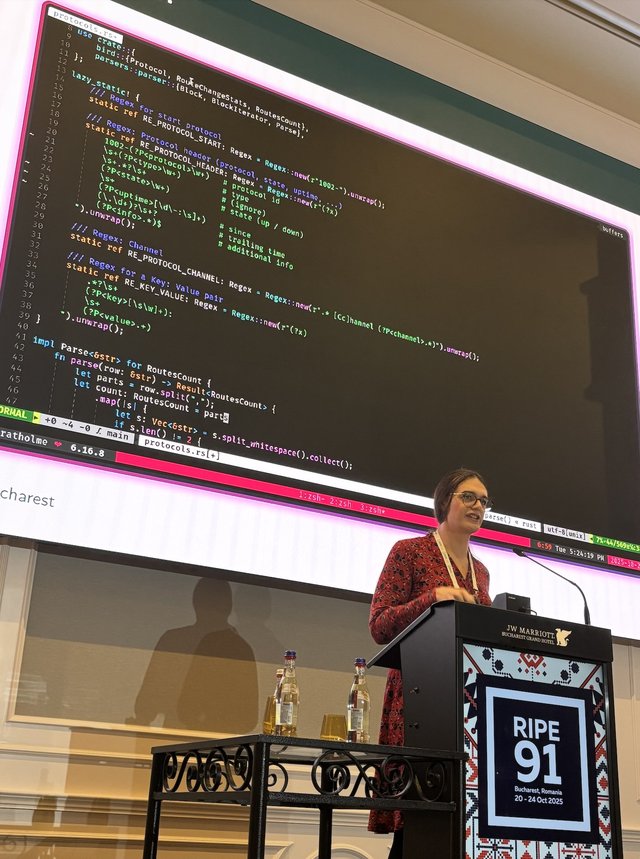
And on the topic of beautiful code, Ondřej Surý (ISC) talked about streamlining the process behind open source release engineering - going over some of the things that make release engineers silently (and then not so silently) scream into the void. Ondřej proposed another way, reminding us all: computer programming is an art, and it produces objects of beauty!
Routing
Over to the Routing WG! Lisa Bruder and Moritz Müller kicked things off with a neat GCA prototype that checks MNRS+ compliance during a peering session. Andrei Robachevsky (GCA) let everyone know he’s around all week for questions - think “office hours,” just with more BGP.
Tim Bruijnzeels (RIPE NCC) followed with an ASPA 101: how it works, how you can already try it in the public RPKI testbed, and why your ASPA objects really need to match operational reality (otherwise: gremlins). He asked if RIPE NCC should tell RPKI Dashboard users which operators to include. The room’s verdict: nice idea in theory, minefield in practice. But a gentle nudge - like “hey, you might’ve missed a provider” - got a big thumbs-up.
Next up, Orlando Eduardo Martínez-Durive showed how fuzzy Maximum-Prefix Limits between BGP peers can nuke sessions. Short term, his advice was "hope for the best, set your limits a little higher, and carry an umbrella." Long term, maybe we should actually negotiate this limit in BGP.
Finally, James Bensley (Inter.link) lifted the lid on how plenty of transit providers tweak the BGP origin attribute to pull in more traffic. He joked about buying a slice of 1.0.0.0/8 since lowest address wins the tiebreaker. The catch: it’s a zero-sum game - don’t play and you lose traffic (and patience) from customers. Inter.link does it too, but at least they’re doing it in the open and letting customers opt out.
Cooperation
In the Cooperation WG, Román Ramírez (RootedCON Association) explained RootedCON Association and Cloudflare’s legal appeal against La Liga de Fútbol Profesional. La Lida de Fútbol Profesional had blocked certain Cloudflare IP addresses to protect football match broadcasts, but Román and his colleagues felt this infringed against certain fundamental digital rights, as he felt innocent third parties were being affected by the blocking. He called for attendees now to put in effort to protect digital rights in light of cases like these.
Next, Mike Blanche (independent consultant) delivered another talk on the Digital Networks Act (DNA) and its potential impact on the open Internet. He re-emphasised his earlier point that the DNA’s proposed IP interconnection dispute resolution processes could create a risk for more disputes, not fewer. Following this, we heard an update from the IGF secretariat, delivered by Anja Gengo (Programme Management Officer and NRIs focal point). She followed up on the outcomes of the 2025 IGF in Lillestrøm and noted the efforts underway for the WSIS+20 process, which will have a High-Level Event this upcoming December.
Finally, testing out a new format, there was a panel of speakers - David ‘tale’ Lawrence (IETF Adaptive DNS Discovery Chair & Liaison to ICANN), David 'equinox' Lamparter (NetDEF (Open Source Routing & IPv6)), Jen Linkova (IPv6 Plumber at Google, IETF 6MAN WG chair, and past RIPE IPv6 WG chair) and Sander Steffann, RIPE NCC Executive Board Member) - moderated by Éric Vyncke (IETF INT Area Director). The panel members discussed the similarities and differences between the RIPE community and the IETF, including the challenges faced and efforts they had undertaken at the IETF. They concluded by encouraging RIPE community members to get involved at the IETF (and vice versa for IETF members curious about RIPE!).
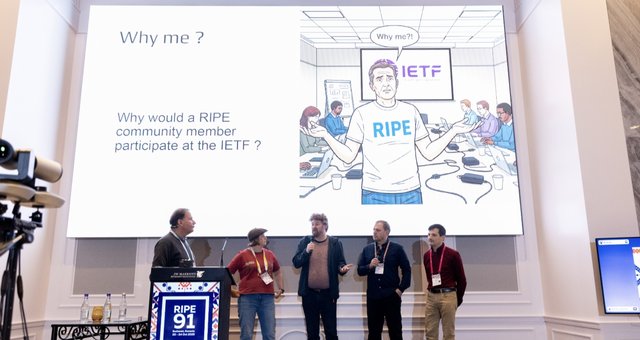
How artificial intelligence might, or might not, shape the RIPE NCC’s future
Your favourite working group, RIPE NCC Services, kicked off with a welcome from chairs János Zsakó, Rob Evans, and Stefan Wahl. Rob Evans volunteered to continue as co-chair and encouraged others to step up in the next election.
Hans Petter Holen, RIPE NCC, presented the draft Activity Plan and Budget 2026. As we enter the final year of the current strategy cycle, Hans Petter outlined the organisation’s priorities: improving registry data accuracy, reducing technical debt, and expanding outreach through a refreshed Fellowship Programme, new courses, and certification. He also stressed the growing importance of monitoring legislation, compliance, and transparency and preparing for the new strategy cycle starting in 2027.
What's the most buzzing topic today? Well, we needed to chip in as well. The session continued with the panel on AI and the RIPE NCC. Antony Gollan, Eleonora Petridou, and Robert Kisteleki and Gabor de Wit (joined remotely) discussed how artificial intelligence might, or might not, shape the RIPE NCC’s work. Well, AI is the future of the RIPE NCC’s services - that’s what the majority of the audience polled in the room thought… or… wait… was that higher number in support of this motion actually the clock?
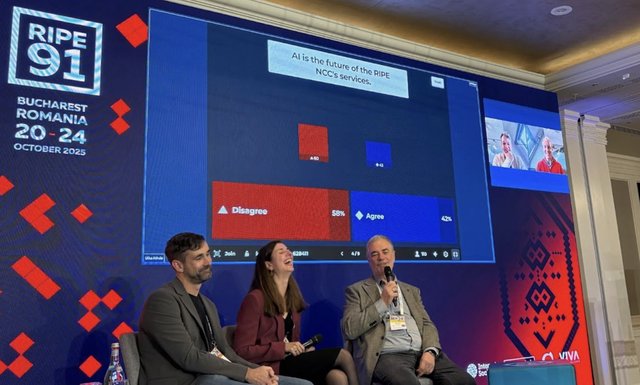
Eleonora noted that every new technology brings both opportunities and risks, especially for security. Antony shared the communications team’s experiments with large language models, sometimes helpful, sometimes hilariously chaotic (“slop” being the word of the day). Gábor reminded everyone that humans still come first, even in a world of AI-driven customer service. And Robert gave a peek into ongoing experiments in measurement systems, where automation and data mining show real potential. An important factor that should be kept in mind is the environmental impact the AI technologies have.
One takeaway stood out: the RIPE NCC may embrace AI, but it’s important to keep the human factor alive and well. Notably, by the end of the panel, the opening poll was run a second time, and this time even fewer respondents supported the motion.
Hans Petter Holen came back on stage to present a brief high-level overview of the draft RIPE NCC strategy that (hint) might have AI on the agenda.
The day drew to a close with the members-only General Meeting, leaving the rest of us free to explore Bucharest, except for those poor lost souls masochistic enough to participate in the RIPE NCC’s corporate governance.


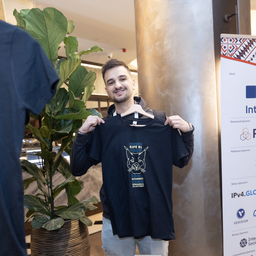
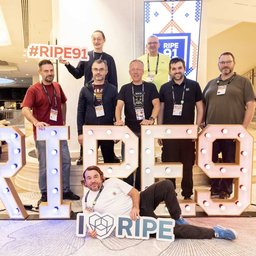
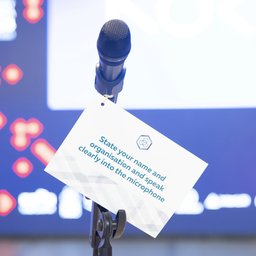
Comments 0